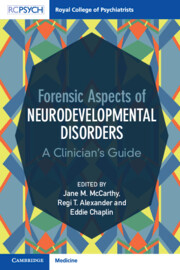Book contents
- Forensic Aspects of Neurodevelopmental Disorders
- Forensic Aspects of Neurodevelopmental Disorders
- Copyright page
- About the Cover Page
- Contents
- Contributors
- Foreword by the Rt Hon Lord Bradley
- Terminology Used in the Book
- Section 1 An Overview: Definitions, Epidemiology and Policy Issues
- Chapter 1 Introduction
- Chapter 2 Aetiology of Neurodevelopmental Disorders
- Chapter 3 Overview of Offenders with Intellectual Disability
- Chapter 4 Overview of Offenders with Attention Deficit Hyperactivity Disorder
- Chapter 5 Overview of Offenders with Autism Spectrum Disorder
- Chapter 6 Associations between Autism Spectrum Disorder and Types of Offences
- Chapter 7 Overview of Young People with Neurodevelopmental Impairments in Contact with the Youth Justice System
- Chapter 8 Overview of Offenders with Fetal Alcohol Spectrum Disorders
- Chapter 9 The Role of Subthreshold Neurodevelopmental Disorder in Offending Behaviour
- Chapter 10 Comorbid Mental Disorders and Neurodevelopmental Conditions
- Section 2 Assessment and Therapeutic Approach
- Section 3 Criminal Justice Pathways and Legal Issues
- Index
- References
Chapter 5 - Overview of Offenders with Autism Spectrum Disorder
from Section 1 - An Overview: Definitions, Epidemiology and Policy Issues
Published online by Cambridge University Press: 18 May 2023
- Forensic Aspects of Neurodevelopmental Disorders
- Forensic Aspects of Neurodevelopmental Disorders
- Copyright page
- About the Cover Page
- Contents
- Contributors
- Foreword by the Rt Hon Lord Bradley
- Terminology Used in the Book
- Section 1 An Overview: Definitions, Epidemiology and Policy Issues
- Chapter 1 Introduction
- Chapter 2 Aetiology of Neurodevelopmental Disorders
- Chapter 3 Overview of Offenders with Intellectual Disability
- Chapter 4 Overview of Offenders with Attention Deficit Hyperactivity Disorder
- Chapter 5 Overview of Offenders with Autism Spectrum Disorder
- Chapter 6 Associations between Autism Spectrum Disorder and Types of Offences
- Chapter 7 Overview of Young People with Neurodevelopmental Impairments in Contact with the Youth Justice System
- Chapter 8 Overview of Offenders with Fetal Alcohol Spectrum Disorders
- Chapter 9 The Role of Subthreshold Neurodevelopmental Disorder in Offending Behaviour
- Chapter 10 Comorbid Mental Disorders and Neurodevelopmental Conditions
- Section 2 Assessment and Therapeutic Approach
- Section 3 Criminal Justice Pathways and Legal Issues
- Index
- References
Summary
While individuals with autism spectrum disorder (ASD) represent a small proportion of the overall offender population, clinical experience and research evidence suggest they are a diverse group who present with specific difficulties, risk management issues and needs that can challenge the criminal justice system. Although methodological limitations mean that an exact figure of how many individuals with ASD enter this system is unknown, within secure forensic settings, the consensus view suggests that offenders with ASD are likely to be over-represented compared to the prevalence in the general population. This chapter touches on why some individuals with ASD offend, how the media views such individuals, opinions of culpability and the impact this may have on their involvement with the criminal justice system. The influence of government legislation is also discussed and how this is shaping services. While progress continues in the assessment and management of individuals with ASD in the criminal justice system, there remains a need for a more informed and unified approach to how individual difficulties and needs are best addressed.
Keywords
- Type
- Chapter
- Information
- Forensic Aspects of Neurodevelopmental DisordersA Clinician's Guide, pp. 48 - 55Publisher: Cambridge University PressPrint publication year: 2023

